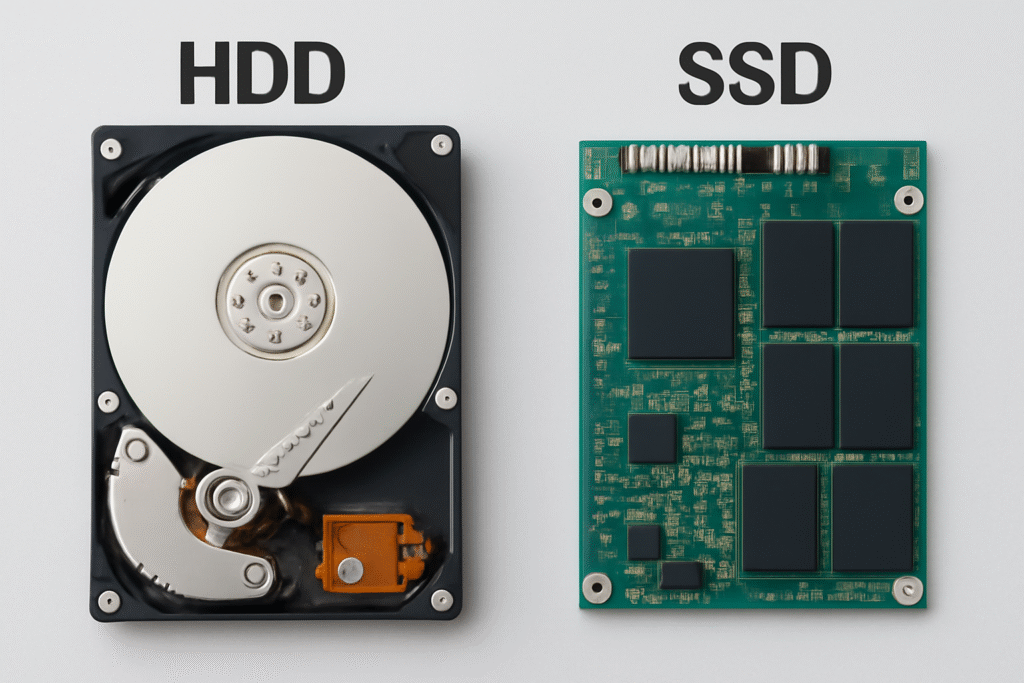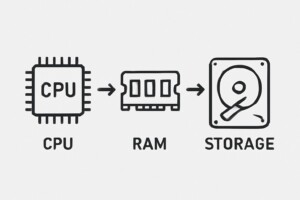Selecting the appropriate size of space to your laptop is one the most crucial decisions to make when purchasing a brand computer or planning to upgrade. There are a variety of storage options from 256GB up to 1TB, and even more, knowing how much storage space you need could save you hundreds of dollars while ensuring that your laptop can meet your needs for computing. This comprehensive guide will cover all you must learn about laptop storage, including the differences in SSD or HDD alternatives to choosing the ideal storage capacity to meet your particular application.
What Types of Storage Are Available for Laptops?
Modern laptops generally utilize two kinds of storage which are Solid-state drives (SSD) and conventional HDD drives (HDD). Knowing the different storage options is essential when buying your laptop or thinking about upgrading. SSDs are the preferred option for laptop storage because of their speed, reliability, as well as energy efficiency when compared to conventional hard disks.

Solid-state drives use flash memory for data storage, which is much faster than a hard disk drive that relies on mechanical components that spin. When you utilize your computer system, the differences in time to boot and speed of loading between SSD and HDD could be significant. Many laptops are now equipped having SSD storage, although some budget models will use traditional hard drives to cut costs.
The storage drive on your laptop acts as a long-term memory storage system for your operating system documents, applications, photographs, videos, and other documents. In contrast to RAM, which is a type of random access memory (RAM) that functions as a short-term memory, the laptop’s storage keeps information even after you shut off the laptop. It is the place where all you need to be aware of about your digital world is stored, including family photos and workplace presentations.
How Much Storage Do Most People Actually Need?
The amount of storage you require is dependent mainly on the way you use your computer as well as the type of files you use. For those who just surf the internet or stream content and use documents, 256GB is enough. But, the majority of users are able to find 512GB to be enough storage space that doesn’t break the budget.
What amount of space space you actually require is dependent on your personal computing habits. Content creators who deal with large files like videos, images or audio recordings generally require at least one TB storage. Similar to gamers, they often need massive storage capacity as games of today can consume between 50 and 100GB every day and the games you play have a direct impact on how much storage space you’ll need.
Image suggestion: infographic illustrating the storage requirements of different user types such as basic gamer, professional, user, and creator[Image suggestion: Infographic showing storage usage by user type – basic, professional, gamer
Professional users who use specific software, have large databases, or require large amounts of local storage for their files should think about their daily storage requirements attentively. It is crucial to determine the amount of storage you will need depending on your current use and the anticipated requirements for the future since laptop upgrades to storage can be costly or even impossible based on the laptop model you have.
What’s the Difference Between RAM and Storage Space?
A lot of people confuse RAM with storage capacity. However these have entirely different purposes in laptops. RAM (random access memory) serves as the laptop’s memory for short-term use, temporarily storing the data your processor needs immediate access to. Storage space is available, regardless of whether SSD or HDD offers long-term storage space for files, apps, as well as your operating system.
The distinction between memory and storage is vital when selecting a laptop. With 16GB of RAM, your laptop to run multiple programs effortlessly; storage space is the determining factor in the amount of data your computer can store permanently. If you require more RAM, you’re solving issues related to multitasking and the speed of your application. If you require additional storage space, you’re addressing issues with capacity associated with file storage.

Knowing this distinction will help you make educated decisions regarding upgrading. There may be a laptop that has great capacity for storage but not enough RAM to meet your requirements or in the opposite direction. How much storage you require for your files is different from the amount of GB of RAM needed to achieve optimal performance. Both are integral to the overall experience of your computer.
Is 256GB Enough Storage for Your Laptop?
A laptop that can hold 256 GB of storage is suitable for those with low storage requirements However, it needs cautious managing of files. After accounting for the operating system, the pre-installed software, and system files, generally, you have around 200GB of usable storage. This is sufficient to accommodate basic productivity software as well as moderate collections of photos as well as essential documents.
But 256GB storage isn’t enough when your digital world expands. The large number of software updates, applications as well as media files may take up a lot of space. Photographers who take lots of pictures, download movies or music, or install multiple programs typically find that 256GB is not enough within the first year of their ownership.
Image suggestion Chart of storage breakdown showing how 256GB is typically allotted to 256GB]
For professionals or students who use cloud-based software and who store the majority of their files online, 256GB of storage may be sufficient. The most important thing is to understand the patterns of your storage and whether you’re able to keep a discipline of regularly shifting documents to external or cloud-based storage. If you prefer to keep everything accessible locally or are working in a location that doesn’t have internet access, then you’ll likely require extra storage.
Should You Choose 512GB or 1TB for Your Laptop Storage?
The option of 512GB or 1TB storage is the perfect space for the majority of laptop users. The 512 GBB storage capacity offers a lot more room to breathe than 256GB while still being affordable. The capacity usually accommodates your operating system’s essential applications, and a moderately large collection of media files allows space for growth in the future without the need for constant managing of files.
For those who deal with huge files, keep large photo libraries, or prefer to keep several games running, 1TB is an excellent value for the long run. The extra storage space relieves the pressure of checking disk usage and offers the flexibility to install future software as well as media storage. The 512GB storage capacity is suitable for the majority of experts, whereas 1TB is ideal for those who create content and power users better.

The price gap between 512 GB versus 1TB has reduced significantly, making bigger capacity more appealing. If you are considering buying a new laptop, take into consideration that upgrades to storage are usually difficult or costly, which makes it worthwhile to purchase enough capacity early. A similar SD storage space offers better value over the long term than trying to manage inadequate storage with external solutions.
How Does SSD Storage Compare to Traditional Hard Drives?
SSD storage provides substantial advantages over traditional hard disk drives for laptops. SSDs have quicker boot times, faster launch of applications, and better overall system performance. The absence of moving components in solid-state drives also makes them more durable and energy efficient, which results in more extended longevity of laptop batteries.
A traditional hard drive generally has greater capacity for storage per dollar, which makes HDD choices appealing to those who require lots of storage for a low price. However, the advantages of SSD storage typically outweigh the costs for the majority of laptop users. The differences in computer performance from SSD or HDD are significant enough to warrant the majority of manufacturers are now using SSDs in their standard devices.
If you’re using your laptop for tasks that require a lot of effort, such as video editing, gaming, or running several applications concurrently, SSD storage becomes essential. The greater speed of writing and reading on SSDs will result in more efficient workflows and shorter wait times. Although you may get the same storage capacity on SSDs at a lower cost than traditional storage devices, their performance lag seldom justifies the cost savings of the primary laptop storage.
When Do You Need More RAM vs More Storage?
Knowing when you require more RAM versus storage will help you improve the performance of your laptop and capacity. If your laptop is slow when it is running several applications, is unable to navigate tabs, or displays an excessive amount of memory in Task Manager, you likely require more RAM, not storage. RAM impacts performance right away and multitasking ability.
If you’re continually eliminating files to free space, aren’t able to install new software, or receive warnings about your disk space being low, you’re in need of more storage, not RAM. Storage issues are manifested as capacity issues, not performance issues. The storage-ram relationship is a mutual one Both contribute to the overall efficiency of the system, but they each have specific issues.
Modern laptops have at least 16GB of RAM to allow for multitasking comfortably, and storage requirements differ depending on how you use your laptop. Professional users usually require adequate RAM and a large storage capacity however, identifying the primary bottlenecks can help you to prioritize the need for upgrades. The amount of memory your laptop requires for RAM is usually constant throughout its lifespan, whereas storage requirements can increase as you add files and upgrade your software.
What Are the Benefits of Upgrading Your Laptop Storage?
The upgrade of your laptop’s storage could significantly improve your experience on the computer; however, the possibility of doing so will depend on the model of your laptop. The latest thin laptops typically come with soldered storage that can’t be upgraded, making the initial choice of storage crucial. Laptops that allow upgrades can be upgraded to increase capacity as demands increase.
The most important reason to upgrade your storage is that it eliminates the ongoing management of the disk space. If you are required to upgrade your storage it gives you the freedom to install apps without worrying about space, manage more extensive local collections of files, as well as avoid performance decline that happens when storage is almost filled. Storage upgrades also allow for better organization of your files and decreased dependence on external storage services.
Cost factors play a significant influence on upgrade choices. It is possible to purchase a laptop that has the smallest SD at first, and later, upgrading can be more affordable; however, this will require ensuring that your laptop can handle upgrades to your storage. The kinds of storage options that can be upgraded are different depending on the laptop models and some support standard 2.5-inch drives while others require specific M.2 shape factors.
How Can Cloud Storage Reduce Your Physical Storage Needs?
Cloud storage solutions like Google Drive, OneDrive, and iCloud can dramatically reduce the amount of physical storage you need by transferring files to distant servers. This is especially beneficial for photos, documents, and other personal documents that do not require constant access locally. Cloud-based storage options allow for access across all devices and reduce the storage requirements for your computer.
However, relying on cloud storage is dependent on a constant internet connection. It might not be suitable for those who frequently travel or work in areas that have poor internet connectivity. Videos or large photo libraries may also be difficult to access regularly through cloud storage because of download time limits and bandwidth restrictions.
The most efficient method often involves combining cloud and local storage to make the most of the cloud. Save frequently used documents, applications as well as current projects on your laptop’s internal storage while conserving older files and less frequently utilized documents to cloud storage. This method of hybridization maximizes the advantages of both storage types while minimizing the limitations of each.
How to Determine the Right Storage Size for Your Laptop
To determine the amount of space you will need to have on your laptop, begin by studying your use patterns and your future needs. Think about the amount of space that is currently used by media files, applications documents, documents along with systems, and documents. Consider the growth potential over the expected lifetime of your laptop generally three to five years for the majority of users.
Review your storage and workflow to figure out if you prefer to store everything locally or if you are able to utilize cloud storage for specific content. Developerd, content creators, and professionals who use special software usually require plenty of storage locally. On the other hand, individuals who do not have a lot of work can get by with less physical storage, supplemented by cloud-based services.
Think about future-proofing your storage choices. Consider a future-proofing plan for your laptop, since upgrades to storage on laptops can be costly or impossible. The capacity that is adequate now might be a problem within the next two years when software gets more complete, x, and your digital library expands. Based on your specific needs and requirements, investing in more storage capacity in the beginning often yields greater value in the long run than managing inadequate storage using external solutions.
Key Takeaways: Everything You Need to Remember About Laptop Storage
- Storage Type Choose SSD instead of HDD to get better performance as well as reliability and battery life for laptops.
- Maximum Capacity The minimum capacity is 256GB, which is sufficient for most users, but 512GB offers more breathing space for the majority of users.
- The Best Option, 1TB, is an excellent value for users who are power users or content creators, as well as people who would prefer to store their data locally.
- RAM vs. Storage RAM influences multitasking and performance; storage impacts file capacity as well as long-term data retention
- Upgrade considerations A large number of laptops are not upgradeable, which makes the selection of the capacity initially crucial.
- Cloud Integration Combining cloud and local storage to increase capacity while maintaining the performance
- Future Plan: Take into consideration storage requirements three to five years in advance as the digital demands increase in time.
- Usage Evaluation Review your storage patterns currently and workflows to determine the actual needs.
- Cost-Benefit Analyse High capacity storage generally provides greater value over the long term than managing space that is not sufficient.
Professional Requirements Creators of content, game developers, and gamers typically need at minimum 1TB for smooth operation.









